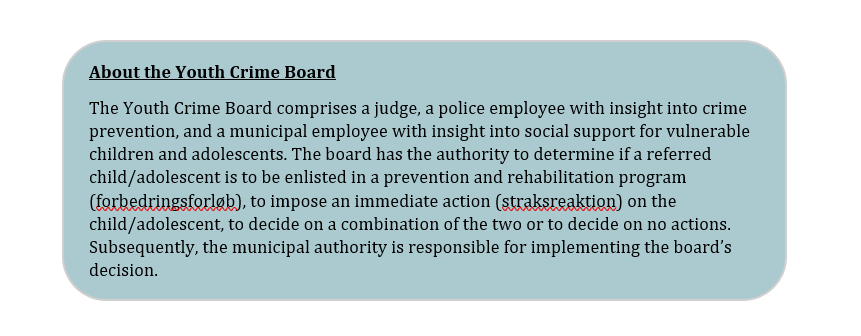By Tine Fuglsang and Signe Bechmann Hansen
In 2018, the Danish Parliament passed a political reform addressing serious youth crime. As part of the reform, the Youth Crime Board (Ungdomskriminalitetsnævnet) was established in 2019.
The objective of the Youth Crime Board is to prevent youth crime, by appointing targeted individual preventive actions for young individuals aged 10-17, who are suspected of (10- to 14-year-olds) or have received a custodial sentence for (15- to 17-year-olds) having committed violent offences or other serious offences. The police refer the 10- to 14-year-olds to the Youth Crime Board, while the 15- to 17-year-olds are referred to the board by the courts.
The Research Division at the Danish Ministry of Justice in Denmark have planned a comprehensive evaluation of the work carried out by Youth Crime Board. The evaluation is scheduled as a six-part evaluation program; the first part of the evaluation focused on the board meetings and the findings were published in a report on the Ministry’s website in May 2021. The remaining five parts of the study will examine the phases preceding and following the board meetings, including an evaluation of the crime preventive effect of the board’s work. Each part of the evaluation will be published separately and continuously until 2024.

The recently published study related to the board meetings is based on the following quantitative and qualitative data: 1) 1,035 cases handled by the Youth Crime Board from January 2019 to August 2020 (these cases involved 1,025 children/adolescents), 2) information from an individual reading of 100 sample cases, 3) a questionnaire answered by professionals e.g. board members, 4) interviews with professionals, and 5) interviews with children/adolescents, who had their case handled by the board.
The study found that 84 per cent of the children/adolescents, whose case was reviewed by the Youth Crime Board, were boys. The number of children/adolescents aged 10-14 and 15-17 were approximately equal. The majority of the children/adolescents were of Danish origin. However, particularly among the 10- to 14-year-olds descendants from non-Western countries were represented. Around a quarter of the 1,025 children/adolescents were placed in out-of-home care, prior to the board meeting. The study also found that the majority of the cases were referred based on violent offences and that in 71 per cent of the cases a prevention and rehabilitation program was imposed, in 1 per cent an immediate action was decided, in 2 per cent both a prevention/rehabilitation program and an immediate action was enforced, and for 27 per cent no action was imposed.
Out of the 100 sample cases, more than half of the children/adolescents were receiving at least one preventive measure through the Social Services Act at the time of the board meeting, and 29 were identified as having a psychiatric diagnose, primarily ADHD or ADD.
The majority of the interviewees – across occupational groups – expressed that they perceive the Youth Crime Board as relevant and meaningful in most cases. They expressed that the Youth Crime Board contributes with a greater focus on the crime perspective in the cases, compared to when a case is handled by the municipalities. In addition, the board is found to ensure that the municipal authorities implement the necessary arrangements.
For further information on the first part of the study of the Youth Crime Board, the full report is available from the Ministry’s website (in Danish).

